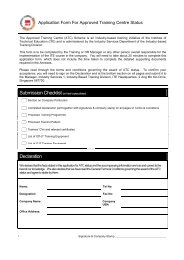Higher Nitec in Civil & Structural Engineering Design - Institute of ...
Higher Nitec in Civil & Structural Engineering Design - Institute of ...
Higher Nitec in Civil & Structural Engineering Design - Institute of ...
Create successful ePaper yourself
Turn your PDF publications into a flip-book with our unique Google optimized e-Paper software.
SCHOOL OF ENGINEERING<br />
COURSE STRUCTURE<br />
Module Title Module Code Credits<br />
GENERAL<br />
Industry Attachment EE49110 2<br />
Industry Attachment EE49120 3<br />
Industry Attachment EE59170 2<br />
Industry Attachment EE59180 3<br />
Overseas Experiential Programme EP49040 2<br />
Overseas Experiential Programme EP49050 3<br />
Overseas Experiential Programme EP59040 2<br />
Overseas Experiential Programme EP59050 3<br />
Note: The <strong>of</strong>fer <strong>of</strong> electives is subject to the tra<strong>in</strong><strong>in</strong>g schedule <strong>of</strong><br />
respective ITE Colleges. Students are advised to check with<br />
their Class Advisors on the availability <strong>of</strong> the elective modules<br />
they <strong>in</strong>tend to pursue.<br />
MODULE OBJECTIVES<br />
Core Modules<br />
Electrotechnology<br />
On completion <strong>of</strong> the module, students should be able to <strong>in</strong>terpret,<br />
measure and troubleshoot electrical circuits and systems.<br />
Industrial Electronics<br />
On completion <strong>of</strong> the module, students should be able to <strong>in</strong>terpret,<br />
construct, test and troubleshoot analogue, digital and power<br />
electronic devices and circuits.<br />
Mathematics and Programm<strong>in</strong>g Methodology<br />
On completion <strong>of</strong> the module, students should be able to<br />
apply knowledge <strong>of</strong> mathematics to solve eng<strong>in</strong>eer<strong>in</strong>g related<br />
problems <strong>in</strong>volv<strong>in</strong>g the use <strong>of</strong> algebra, <strong>in</strong>dices, logarithms, graphs,<br />
trigonometry and complex numbers. In addition, students would be<br />
tra<strong>in</strong>ed to write simple computer programs to solve mathematical<br />
and eng<strong>in</strong>eer<strong>in</strong>g problems.<br />
Electrical <strong>Design</strong> and CAD<br />
On completion <strong>of</strong> the module, students should be able to use CAD<br />
s<strong>of</strong>tware to design and produce electrical draw<strong>in</strong>gs and diagrams <strong>in</strong><br />
compliance with regulations and codes <strong>of</strong> practice.<br />
Electrical Installation and Intelligent Control System<br />
On completion <strong>of</strong> the module, students should be able to <strong>in</strong>stall,<br />
control and ma<strong>in</strong>ta<strong>in</strong> domestic, commercial, <strong>in</strong>dustrial as well as<br />
special electrical <strong>in</strong>stallations, electrical motor <strong>in</strong>stallations and<br />
build<strong>in</strong>g automation systems accord<strong>in</strong>g to the relevant codes <strong>of</strong><br />
practice.<br />
Electrical Mach<strong>in</strong>e and Drives<br />
On completion <strong>of</strong> the module, students should be able to start up,<br />
operate, test and/or control the speed <strong>of</strong> DC and AC mach<strong>in</strong>es<br />
and electrical equipment, expla<strong>in</strong> their construction, pr<strong>in</strong>ciples <strong>of</strong><br />
operation, operat<strong>in</strong>g characteristics and applications.<br />
Instrumentation and Control Systems<br />
On completion <strong>of</strong> the module, students should be able to operate<br />
and calibrate process <strong>in</strong>struments and equipment, implement PLC<br />
projects and control and ma<strong>in</strong>ta<strong>in</strong> process control systems.<br />
Electrical Power System<br />
On completion <strong>of</strong> the module, students should be able to operate<br />
and ma<strong>in</strong>ta<strong>in</strong> electrical power systems and equipment, <strong>in</strong>clud<strong>in</strong>g<br />
power factor correction equipment, motor control centres, electrical<br />
switchboards, protective relays, switchgears, power cables, standby<br />
generators and un<strong>in</strong>terruptible power supplies.<br />
Project<br />
On completion <strong>of</strong> the module, students should be able to <strong>in</strong>tegrate<br />
and apply a cluster <strong>of</strong> key technical, social and methodological<br />
competencies <strong>in</strong> carry<strong>in</strong>g out a project related to their field <strong>of</strong> study.<br />
Life Skills Modules<br />
Life skills <strong>in</strong> broad terms are the foundation skills and personal<br />
qualities that an <strong>in</strong>dividual can transfer from one job sett<strong>in</strong>g to<br />
another to manage and adapt to changes <strong>in</strong> technology and work<br />
environments.<br />
Electives (Course Specific)<br />
Electrical Measurement<br />
On completion <strong>of</strong> the module, students should be able to use common<br />
analogue and digital <strong>in</strong>struments to measure current, voltage,<br />
resistance, speed and frequency; and deploy DC potentiometers<br />
for various applications. They are also tra<strong>in</strong>ed <strong>in</strong> the pr<strong>in</strong>ciples <strong>of</strong><br />
operation, use and limitations <strong>of</strong> the equipment.<br />
215



![[CHOICE] - Institute of Technical Education](https://img.yumpu.com/23578991/1/184x260/choice-institute-of-technical-education.jpg?quality=85)

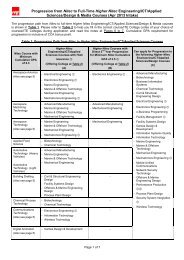

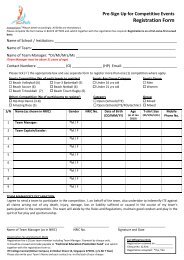
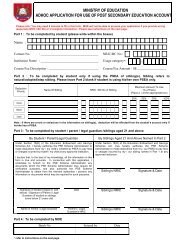
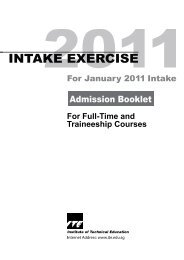



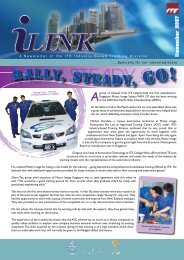
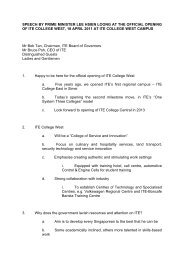
![FAQs for Full-time Nitec Jan 2012 Intake [JIE 'N']](https://img.yumpu.com/23578955/1/190x245/faqs-for-full-time-nitec-jan-2012-intake-jie-n.jpg?quality=85)
